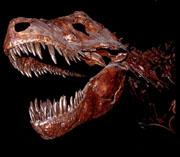 The discovery offers a valuable glimpse at Tyrannosaurus rex 's biology.© Alamy
The discovery offers a valuable glimpse at Tyrannosaurus rex 's biology.© AlamyA thigh bone from a 70-million-year-old Tyrannosaurus rex has given fossil experts an unexpected treasure: well-preserved soft tissue. The stretchy material, which may contain the remnants of blood vessels and cells, could shed light on how dinosaurs' bodies worked.
Although palaeontologists have had plenty of bones with which to work, they have struggled to find relics of the muscles, organs and blood vessels that once kept giants like T. rex on the move. These soft tissues decay quickly and are rarely fossilized.
“This is not something I ever dreamed I'd see.”
Mary Schweitzer
North Carolina State University, Raleigh, North Carolina
So far, the best view inside dinosaurs has come from rocky fossils that preserve the shape of the original tissue. Even these finds are extremely rare, as they are only produced when minerals replace these soft parts or fill in the cavities they leave after decaying.
Now, however, researchers have got their hands on the real thing. The fossil was unearthed in Montana by a team led by Mary Schweitzer of North Carolina State University in Raleigh.
"I've spent my career trying to recover itty-bitty pieces of original proteins," Schweitzer says. "This is certainly not something I ever dreamed I'd see." The researchers report their discovery in Science1.
Bred in the bone
Most palaeontologists don't look inside bones, in fact, they do their best to keep them intact. But Schweitzer and her colleague Jack Horner, of the Museum of the Rockies in Bozeman, Montana, prefer to think of them as 'wrapping paper' for the once-living material inside.
To isolate the soft tissue lining the bone's marrow cavity, they co-opted a technique used to study modern bone. Schweitzer likens it to sticking a chicken bone in vinegar: the hard, calcium-containing component dissolves, leaving a supple matrix behind.
 After stripping away the bone's hard minerals, the white fibrous matrix can be seen.© Science
After stripping away the bone's hard minerals, the white fibrous matrix can be seen.© ScienceFrom this matrix, the treatment released translucent vessels that floated freely in solution. They were spotted with small, red-brown dots that may be nuclei of the cells that formed the vessel.
Inside the vessels, the researchers found tiny structures that look like bone cells, called osteocytes. Surprisingly, they resembled cells from modern ostrich bone, right down to details such as the oval shape of the putative nuclei, and flexible extensions from the cell membrane that are used to exchange waste.
Schweitzer intends to analyse the sample to find out exactly what it comprises. Although the seeming cells and blood vessels are organic, the researchers don't know whether they represent the original material or a new type of fossilization that has not been seen before.
If they could sequence actual protein fragments from the sample, the researchers could learn much more about how dinosaurs are related to modern animals, especially birds. They might even find out whether T. rex was warm- or cold-blooded.
Age-old riddle
Tissues from other ancient organisms, such as insects trapped in amber, have been discovered almost intact. But Schweitzer and her colleagues still don't know how this dinosaur tissue has remained so well preserved for so long.
ADVERTISEMENT
It is possible that other ancient vertebrate fossils could contain soft tissue, potentially paving the way for comparisons between species, says Derek Briggs, an expert on exceptionally preserved fossils at Yale University in New Haven, Connecticut. "This sort of information becomes a lot more significant if there's a chance of finding it for a range of different types of dinosaurs and fossil vertebrates," he says.
Schweitzer is reluctant to say whether she is attempting to isolate DNA from the tissue. But could such work lead to the recreation of dinosaurs, in the style of the Hollywood blockbuster Jurassic Park? DNA cannot survive that long, says Briggs, "My answer would be an emphatic no."
North Carolina State University, Raleigh, North Carolina
